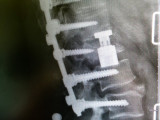SCOTT TANSEY HAS always been a man of faith. More or less. Probably less lately, he admits. But one foggy, rainy morning last year, he says, “God gave me a good, ole shaking and said ‘Hey, enough already!’”
Before dawn that day, Tansey, who is a member of Local 667 (Charleston, West Virginia), got in his truck and left a campground in Paxico, Kansas, to do some work for Local 83 (Kansas City, Missouri) at Jeffrey Energy in St. Marys, Kansas. It was around 4:30 a.m., and he was thinking about some welding inspections he needed to do. That’s when he missed a turn and hit an embankment at 65 miles-per-hour. His truck careened between a guidewire and a telephone pole and crashed through a sign before coming to rest on all four tires in a cornfield.
Stunned but still conscious, Tansey immediately felt like his tailbone and lower body were on fire. “I thought maybe the heated seats in the truck had shorted out and caught on fire,” he says.
He had to climb into the back-passenger seat to get out because none of the other doors would open. When he finally got out of his truck, he walked around it and inspected the damage while calling 911 and his wife, Jennifer, back in their hometown of Bates City, Missouri. He then settled into the back seat to wait for the EMTs to arrive.
“My adrenaline was pumping. It seemed like forever but was probably only 15 or 20 minutes before they got there,” he recalls. “And boy, was I glad to see them!”
After assessing Tansey’s injuries and noting he had gone into shock, the attendants hurriedly immobilized him on a backboard and rushed him to a local hospital, where Jennifer met them at the emergency room. He doesn’t remember much of the 15-minute ambulance ride except the creak of ambulance the door opening and rain hitting him in the face as he was whisked into the hospital and then into an assessment bay.
Much later, Tansey awoke to a doctor telling Jennifer that they needed to get him to a trauma center ASAP because his injuries were more serious than the hospital was prepared to handle.
The stormy weather made it too dangerous for a life flight helicopter to take him to the nearest trauma center so, once again, Tansey was completely restrained, gingerly loaded into an ambulance and rushed 30 minutes away to Stormont Vale Hospital in Topeka, Kansas.
After an extensive examination and multiple tests, doctors explained to Tansey and his wife that his first lumbar vertebrae (L1) was fractured, that he had literally “broken his back in half.” He needed surgery immediately to remove a bone fragment resting against his spinal cord that could easily shift and cause, at best, complete paralysis of his lower body, and at worst, death. The fact that he had walked around the truck right after the crash and hadn’t caused further damage was, they said, “a miracle.”
By this time, Tansey’s dad had made the 14-hour drive from Parkersburg, West Virginia, to Topeka to be with his son and family during the long hours of his grueling surgery. As Jennifer paced the sterile waiting room and hospital hallways with other family members, their 11-year-old son, Zachery, was at home with relatives.
Tansey’s surgery was a complete success. The floating fragment was removed, and doctors inserted two steel rods in Tansey’s spine to fuse the L1 vertebrae with the two above it and the two below it.
The prognosis: Tansey would have to learn how to walk again and was expected to spend two to three weeks in the hospital and one to two months in an in-patient rehabilitation facility.
The reality: Tansey left the hospital in just eight days, using only a walker and wearing a shoulder-to-waist turtle shell body brace.
“It was largely due to my wife,” he says. “Jennifer pushed me very hard. She and the nurse would walk me up and down the hallway on my walker, and then I started doing loops of the wing I was in. It was painful, but she pushed me.” And the medical staff was amazed.
Tansey continued his recovery at home with the help of Jennifer and Zachery, who took charge of helping Tansey put on and take off his brace. He was back to work in three months.
And that sign his truck hit? It was for a church. “I took that as my ‘sign.’ Something was telling me that I needed to straighten up and get my life right,” he says. “It was definitely a wakeup call. I had an angel riding with me that day.”
Tansey says he was raised in the church and that his accident was the push he needed to reevaluate his priorities. “It really hit home,” he says. “It had to start with me first. I needed to really decide what was important to me. Now, when I’m not working, I spend as much time with my family as I can.”
He also recalls how this experience opened his eyes to give a little more freely when jobsite collections are taken up for those in need. “You never know how bad the person really needs it and how much it means to them until you’ve been in that position. If someone is on a collection, they really need it.
“This whole instance has taught me why we call this union a brotherhood. The prayers, the phone calls, the texts, the collections, the love that was shown—we were overwhelmed,” he says. “I don’t know where we’d be without it. There’s a very good chance we would have lost everything we owned if it hadn’t been for all the financial assistance from my union brothers and sisters from both Jeffrey Energy and Local 83.”







